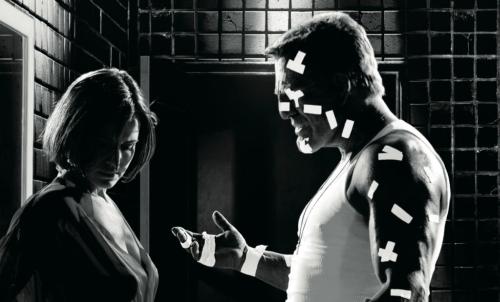 I'm currently in "black and white phase." It seems that everything I'm writing, filming, and even thinking up recently is in black and white, as evidenced by The Mercury Men. Over the past year, as I discuss the two features I've been developing with various people there is always great concern over them being in black and white. I have to confess I've never quite understood the prejudice towards it. People say "it looks old." What's wrong with something that looks old? And I'd say classic before I said old. Others say "it's really bland, boring." To that I say you're bonkers. Tell me the inserted shots from The Third Man and Sin City look bland or boring. Can you imagine Sin City in color?
I'm currently in "black and white phase." It seems that everything I'm writing, filming, and even thinking up recently is in black and white, as evidenced by The Mercury Men. Over the past year, as I discuss the two features I've been developing with various people there is always great concern over them being in black and white. I have to confess I've never quite understood the prejudice towards it. People say "it looks old." What's wrong with something that looks old? And I'd say classic before I said old. Others say "it's really bland, boring." To that I say you're bonkers. Tell me the inserted shots from The Third Man and Sin City look bland or boring. Can you imagine Sin City in color? Orson Welles called black and white "an actor's best friend," because it focused the audiences attention on the actor rather than the sets, the costumes, etc. Not only do I agree, but I'd take it one step further and say it's a director's best friend as well. Black and white illuminates the framing and composition. Since the brain doesn't have to take in and process colors it focuses elsewhere and it just so happens to land on the most important parts.
Orson Welles called black and white "an actor's best friend," because it focused the audiences attention on the actor rather than the sets, the costumes, etc. Not only do I agree, but I'd take it one step further and say it's a director's best friend as well. Black and white illuminates the framing and composition. Since the brain doesn't have to take in and process colors it focuses elsewhere and it just so happens to land on the most important parts. I found this clip on YouTube today of Frank Darabont discussing how he had wanted to release his latest film The Mist in black and white. He claims the studios wouldn't even entertain the idea. I realize nobody could say how audiences would have reacted had the film been released in black and white but I know one thing for sure: they would have noticed it. When the trailers for The Mist hit screens it looked just like every other horror movie. Had it been black and white audiences would have at least paid a bit more attention for the simple reason that it looked different. Moriarty over at Aint It Cool News claims that had the film been in black and white it would have made his top ten films of the year, rather than lying around somewhere in the top 50. If only the studios would have been a bit more brave.
I found this clip on YouTube today of Frank Darabont discussing how he had wanted to release his latest film The Mist in black and white. He claims the studios wouldn't even entertain the idea. I realize nobody could say how audiences would have reacted had the film been released in black and white but I know one thing for sure: they would have noticed it. When the trailers for The Mist hit screens it looked just like every other horror movie. Had it been black and white audiences would have at least paid a bit more attention for the simple reason that it looked different. Moriarty over at Aint It Cool News claims that had the film been in black and white it would have made his top ten films of the year, rather than lying around somewhere in the top 50. If only the studios would have been a bit more brave.
Monday, March 24, 2008
Black and White
Subscribe to:
Post Comments (Atom)






No comments:
Post a Comment